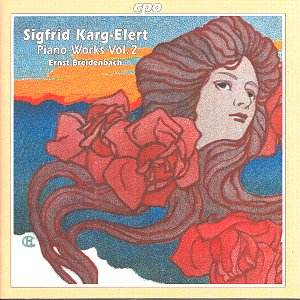"Piano tuning: Andreas Berg" it says. I've never
seen the piano tuner named before, and since I noticed it (about twenty
minutes in) I found myself listening to that aspect almost before all
others. How satisfying to hear the big chords warm and round without
the jarring trace anywhere of a string vibrating just slightly out of
harmony, and what a pleasure to hear an upper register (of which Karg-Elert
makes much use) where the notes sing and there is never a suspicion
that some have been knocked out of tune. Those who choose their discs
according to who tuned the piano can make a bee-line for the nearest
shop.
Now, if you get the idea that what I'm working up to
is that the piano tuning is the one good thing here, well yes and no.
Ernst Breidenbach has what you might call a clean pair of hands. He
puts up a splendid digital display in "Solfeggio", from "Patina",
and also in the finale of the same cycle. But might the first of these
not have been a little lighter? Variety of touch is what seems to be
lacking here, that and a singing tone and an ability to separate the
voices in the texture by tone-colour. Frankly, my reaction to the first
two "Walzerszenen" pieces was of dismay, thinking that such
sub-Schumannesque music stood no chance at all with an interpreter unable
to evoke Schumanesque fantasy. However, the charmingly Dvorakian no.3
made me prick up my ears even if Breidenbach is sticky and doesn't make
the melody sing independently of the harmony. But he does show a very
alert rhythmic sense in the delightfully quirky no. 4 that follows.
Thereafter the musical level falls, and Breidenbach with it. He rises
to the rather nice "Erotik" which opens the op. 23 set, which
is just as well since the booklet-note writer remarks that here "the
highest degree of empathy and impressionistic passion is required of
the interpreter". Really, I think writers should avoid this sort
of comment since, if the interpreter doesn't measure up, the listener
has had his attention crudely drawn to it. And what a vapid piece the
following "Valse Mignonne" is!
The pattern seems to be that Breidenbach is good enough
when Karg-Elert is at his best but not able to convince us when he isn't,
so what of the music?
Karg-Elert is mostly known by organists for pieces
in a romantic vein which sometimes go through patches of almost blues-like
harmony. In a very different context, some of these pieces have similarly
piquant harmonic moments - the already mentioned no. 4 of "Walzerszenen"
("mit burleskem Humor") and especially the pithy Bourrée
from "Patina", which Breidenbach plays with much swing. Karg-Elert
actually trained as a pianist and was not even a very good organist,
so there is no suspicion of an organist trying to write for piano -
even the worst pieces are pianistically effective. I don't know quite
what it says about Karg-Elert's development as a composer that the most
interesting pieces seem the earliest and the latest. I enjoyed most
of "Patina", a quirky visitation of the baroque style written
in 1924, and even more the "Reisebilder" of 1895. This is
perhaps a more conventionally full-blooded romanticism, but it is well-varied
and melodious and brings out the best in Breidenbach.
A mixed bag, then, and I wonder if it is really the
best idea to record "complete" works as people tend to do
nowadays. Of course it has documentary value, those who are curious
can hear pieces of which the scores would not be easy to find even for
those who can play them. But what of the musical value? Are not the
organisers of this project abrogating their responsibility towards the
listener? Do they not have the duty to select the best and give their
public something really worthwhile instead of dumping the lot on them
and saying, practically, "here it all is, make up your own minds".
Another possibility, when dealing with a very uneven composer, is to
mix solo pieces with chamber works and songs (Karg-Elert wrote plenty
of both) to make a listener-friendly sequence. I recently
reviewed a Walford Davies disc (CDLX 7108) which showed what a little
imaginative programming can do.
Christopher Howell

![]() Ernst Breidenbach (pianoforte)
Ernst Breidenbach (pianoforte)
![]() CPO 999 711-2 [79.56]
CPO 999 711-2 [79.56]